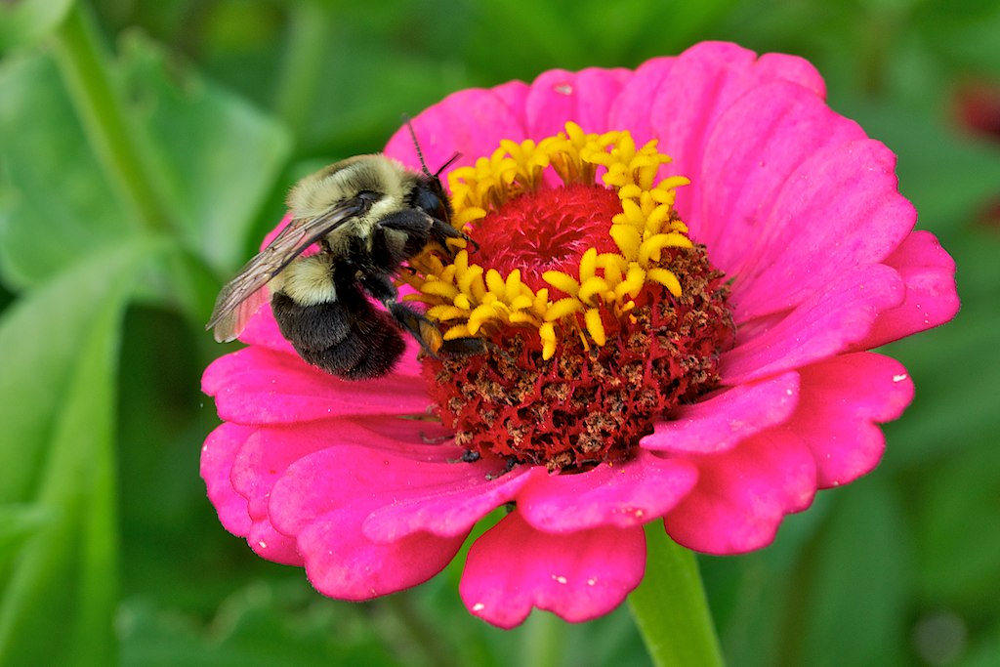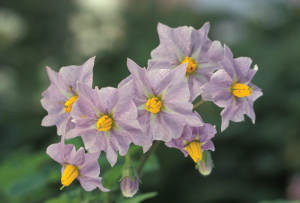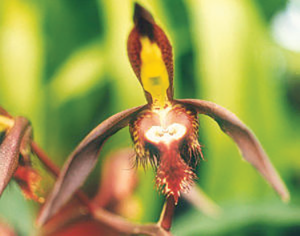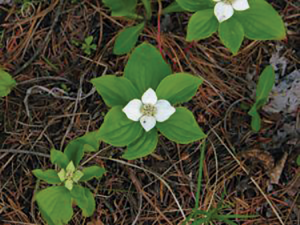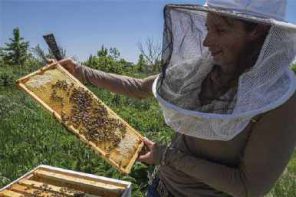The Physics Of Pollination
By: Marie Davey
Pollination. The word brings to mind the droning buzz of fat yellow and black bumblebees bouncing from blossom to blossom in flower-decked meadows.
But up close and in person, pollination is often anything but idyllic. The physical forces involved in pollination can be impressive, and both plants and pollinators must be well adapted to withstand them.
Take the bumblebees that visit potato (Solanum tuberosum). During pollination, bees violently shake the flowers with forces approaching 3Gs – or the equivalent of an astronaut blasting into space. The bees generate the force of a rocket engine by rapidly contracting their flight muscles, and the bigger the bee, the stronger the vibrations this produces. The potato flower’s tolerance for this violent and rapid vibration is no accident either. They’ve evolved to both withstand these levels of force and to encourage their pollinators to shake them.
Why would a plant ask for this kind of abuse? It protects the pollen from being eaten by “cheater” insects that are too small to act as pollinators. Potatoes, tomatoes, and their close relatives have evolved what is known as buzz pollination. Their pollen is kept safe from small insects within tube-like structures called anthers, which open via a pore or small slit at the top of the cylinder. The pollen is dry and granular, but doesn’t easily fall through these pores or slits. When a bumblebee on the hunt for pollen visits the flowers, it grabs the anthers and rapidly shakes them. Pollen flies out of the anthers like a salt shaker, dusting the bee, which then carries the pollen to the hive or to other flowers, pollinating them.
It is not just plants that must resist impressive forces during pollination. The award for toughest pollinator goes to the euglossine bees that have evolved to pollinate Catasetum orchids. Early in the morning, these orchids produce a scent that attracts the bees. Inside the flower is a pollinium made up of two pollen sacs connected to a sticky disk of tissue called a viscidium. Two dangling antennae below the pollinium act as a trigger for this floral trap. When a bee visits the flower, it brushes the antennae, and the orchid launches its pollinium like an arrow toward the pollinator. The pollinium flies through the air twice as fast as a striking snake and sticks tightly to the back of the very surprised bee, which carries it off to the next flower it visits. The impact of the pollinium is the equivalent of a soda can falling onto a human from the top of a 10-story building, so it is impressive that the bees withstand this kind of abuse.
Judging from the fact that bees that have experienced this floral smack scrupulously avoid visiting male Catasetum flowers ever again, the sudden impact of the pollinium is a particularly unpleasant experience for the bee. It is no surprise that female Catasetum orchids have evolved to look very different from their male counterparts, so that the wary bees will visit them despite their previous experiences.
The flowers of bunchberry (Cornus canadensis) act like tiny pollen catapults that are triggered by bees visiting the flowers. Bunchberry flower buds have petals that are fused to one another and completely enclose the stalked stamens that contain the pollen. Because of the limited space within the flower blossom, these stamens are forced to bend as they grow, storing elastic energy in their springy stalks. When a pollinator forces open the petals or the flower matures and the petals open on their own, the elastic energy stored in the stamen’s stalk is suddenly released, and the pollen is flung upward at speeds in excess of 20 km/h. The catapulted pollen either sprays the hapless bee that has triggered the sudden opening of the petals or is flung high enough above the flower to be caught and carried off by air currents.
But the physical forces at play during pollination are not just about speed and strength. Some of them are positively electric. Bees not only have the ability to sense electric charges through the fine hairs that cover their bodies, they also carry a charge themselves. Much like rubbing a balloon on a wool sweater can give it a static electric charge strong enough to make it stick to a wall, rapidly flapping bee wings rub against particles of dust in the air, giving the bee a positive static electric charge. Flowers and pollen, on the other hand, are negatively charged, so when a bee visits a flower, the laws of attraction come into play. The positively charged bee will attract the negatively charged pollen grains. Because of their tiny size, the pollen grains literally fly towards the bee and stick firmly to it. The bee’s visit also temporarily changes the electric charge of the flower, which acts like an electric sign for other bees, warning them this flower has recently been harvested by another bee and may be low on pollen and nectar.
Sometimes pollination physics are a delicate, perfectly engineered balance. Snapdragon flowers (Antirrhinum majus) are tube-like, with an opening that is protected by petals that form two tightly closed lips. The weight of a bee landing on the lip of the flower causes its mouth to pop open, so the bee can crawl inside, rubbing against the pollen-containing anthers that are found around the rim of the tube. This trap door mechanism is another example of a flower protecting itself from “cheater” insects that would rob nectar and pollen from the flower without pollinating it. Insects too small to touch the edges of the tube and get covered in pollen are not heavy enough to open the lips of the flower. As an extra insurance policy, the flowers also lay out an anti-slip welcome mat for the bees. At the microscopic level, the spots on the petals where a bee would land are covered in bumpy cells that increase friction and provide the perfect surface for the bee’s tarsal claws to hold on to. Everywhere else on the petals, the cells are smooth and slippery, making it difficult for other insects to crawl up to the lips of the flower, especially in windy conditions.
If it’s perfectly engineered bee size trapdoors in flowers or bees generating forces comparable to an average roller coaster, the physics behind pollination represent a marvel of evolution and impressive resilience.
Dr. Marie Davey is a researcher in mycology and molecular ecology at the University of Oslo with a PhD from the University of Alberta. She is interested in all aspects of science and its intersection with society, and has also worked as a science policy advisor and environmental consultant.







